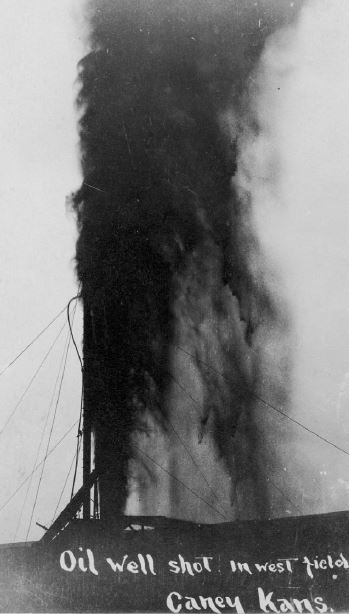Oil fever reached southeastern Kansas by the early 1900s. In October 1904, Missouri investors saw an opportunity in a new oil company with wells near proven oilfields at the Kansas-Oklahoma border.
Cahege Oil & Gas Company, headquartered in Carrollton, Missouri, leased 15,000 acres near Caney, Kansas, a region that had produced oil since the early 1890s.
According to the Daily Traveler newspaper in Arkansas City, Kansas, the recently formed company was drilling exploratory wells near Caney – and had “shot two wells on the Broome and St. John leases.”
The explosive technology, originally patented by Civil War veteran Col. Edward Roberts, typically ignited a downhole canister filled with nitroglycerin to increase oil production. It was an expensive and risky process – and a great way to draw crowds. Learn more in Shooters – A Fracking History.

Dramatic, but dangerous and wasteful, “shooting” technologies would improve with invention of the blow-out preventor in 1922.
To encourage potential investors, Cahege Oil & Gas offered $5 round-trip excursions from Keytesville, Missouri, to its two Kansas wells, about 290 miles away.
Although oil prices had fallen, Keytesville’s Chariton Courier newspaper endorsed the drilling venture. The oil company took advantage of public fascination with “black gold,” which had grown following an 1897 discovery along the Caney River 20 miles south. See First Oklahoma Oil Well.
“At an extremely low estimate I place the wells at 50 barrels, although at present day either of them will do 125 barrels,” one Cahege Oil & Gas representative declared.
At the time – with discoveries at Bartlesville in Indian Territory and southeastern Texas after the 1901 “Lucas Gusher” at Spindletop – oil sold for 86 cents a barrel (about $22 in 2013 dollars). See Spindletop launches Modern Petroleum Industry. Cahege Oil & Gas common stock sold for 10 cents a share and reached as high as 12 cents a share.
“From what the editor of the Courier has investigated of the enterprise, we believe the stock-holders have a good thing ahead,” proclaimed the newspaper.

Petroleum wealth brought new industries to Caney, Kansas, and helped build McKinnley School, circa 1909.
“Some seven or eight parties in Keytesville have bought stock and we hope they will reap large return on their investments,” the paper added.
It didn’t happen. With low prices and high drilling costs, Cahege Oil & Gas operated for just one more year. By 1905, after reportedly drilling a third well, the company disappeared from Kansas and Missouri financial records. Cahege Oil & Gas stock certificates today may have value for scripophily collectors.
Some historians note that in 1905 Harry Sinclair drilled his first oil well at Caney before making his first fortune at the Glenn Pool oilfield south of Tulsa. Learn more about Glenn Pool’s discovery in Making Tulsa the Oil Capital.
In 1906, Caney made headlines as far way as Los Angeles after a February 23 lighting strike ignited a natural gas well that burned for more than a month. Regular updates covered attempts to extinguish the well, “which defied the ingenuity of man to subdue its roaring flames.” Read more in Kansas Gas Well Fire.
Read about another small Kansas town changed by petroleum. The Stapleton No. 1 oil well in El Dorado launched the first major Kansas Oil Boom.
___________________________________________________________________________________
The stories of other attempts to join petroleum exploration booms (and avoid busts) can be found in an updated series of research at Is my Old Oil Stock worth Anything?
___________________________________________________________________________________
Please support the American Oil & Gas Historical Society and this website with a donation.

